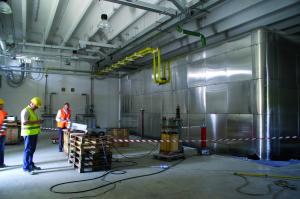First European component installed at neutral beam test facility
31 Aug 2015
The European high voltage deck for SPIDER (at right) undergoes acceptance testing at the PRIMA neutral beam test facility in Padua, Italy.
At the PRIMA neutral beam test facility in Padua, Italy, an ITER-scale radio-frequency negative ion source (SPIDER) and a full-scale neutral beam injector at full acceleration voltage and power (MITICA) will be tested to help resolve challenging physics and technology issues and validate concepts before the heating neutral beam system is built at ITER. Europe, Japan and India are contributing all components according to the specifications from the ITER Organization; Italy has constructed the facility as a voluntary contribution to the neutral beam development program.
In August, the European Domestic Agency Fusion for Energy reported that the first European component—a high voltage deck for SPIDER—has been delivered and accepted. (Last December, India reported the delivery of the SPIDER beam dump.)
The European agency collaborated with the Italian company COELME for the design, manufacture and installation of the high voltage deck, a mechanical structure that will hold power supply equipment weighing around 40 tonnes. The delivery and acceptance of the component marks the end of a four-month installation period during which each individual sub-component underwent verification before the final electric tests were performed on the ensemble.
"This is a major achievement," said Daniel Gutierrez, technical officer for the European Domestic Agency. "We are especially pleased because we have not faced any major problems during installation or testing and everything has been carried out in accordance with our planned time schedule. The HVD is now ready to host the ion source and extraction power supplies (ISEPS) which are necessary for feeding the ion source of the neutral beam injector."
The high voltage deck, which measures approximately 11 x 13 metres, is installed in a pit approximately one metre below ground level and is mounted on supporting insulators to withstand the high 100 kV voltage of the power supplies. The deck is covered by a closed aluminium screen that reduces electromagnetic interference which could have a negative effect on the equipment and the power supply.
The acceptance of the high voltage deck is not the end of Europe's collaboration with COELME. The next step is the SPIDER transmission line, which will connect the power supplies installed inside the high voltage deck to the SPIDER ion source and beam acceleration. Measuring around 30 metres in length, the transmission line will use unique double-screening sandwich panels which give extra protection against electromagnetic interference. Manufacturing is scheduled to be completed by November and site installation should begin before the end of the year.
Read the original story on the European Domestic Agency website.


